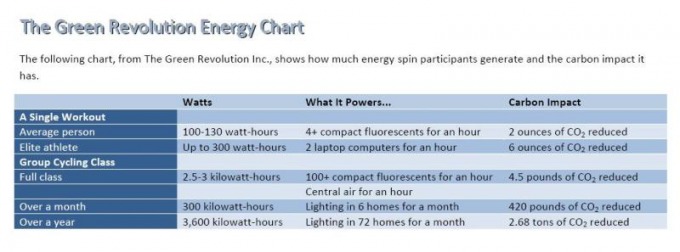|
With Earth Day a not so distant memory, consider sharing these statistics with your cycle participants courtesy of www.egreenrevolution.com. Now, if we could harness this energy production on our spin bikes, we could maybe power our stereo during class!
What other eco-friendly things can you do in your cycle class? Comments are welcome. Please share ideas and suggestions!
0 Comments
As discussed in my last blog post, Rating of Perceived Exertion (RPE) is one way to monitor intensity in a cycle class. Being a visual learner myself, I appreciate any form of visual cueing during a cycle class. I have created individual RPE cards, which are affixed to each bike (see picture below for an example). I encourage cycle participants to use the card throughout the class to monitor intensity. The cards cover the modified Borg RPE scale (0-10), which seems to be easier to follow than the traditional Borg RPE scale (6-20). When I use the cards in class, I start with a brief overview of what the numbers represent and how the scale is a subjective assessment of each individual’s exertion level or intensity. Ensure to clearly describe! The following two drills are one way to use the cards in your class: To start, set a baseline tension and cadence to match a 3-4/10 for a moderate to somewhat hard exertion. This can be tricky to begin with so take time to let participants juggle tension and cadence to find the right balance.  1.Use tension only to set the exertion. Maintain a cadence of 80-90 rpm. Each section can be held for 30-60 seconds depending on the physical fitness of your group. Add tension to a rating of 5/10 (hard) Take tension off to a rating of 3/10 (moderate) Add tension to a rating of 7/10 (very hard) Take tension off to a rating of 2/10 (light) 2.Use cadence only to set the exertion. Maintain tension at moderate or slightly higher resistance (steady state tension). Each section can be held for 30-60 seconds depending on the physical fitness of your group. Increase cadence to a rating of 5/10 (hard) Decrease cadence to a rating of 3/10 (moderate) Increase cadence to a rating of 7/10 (very hard) Decrease cadence to a rating of 2/10 (light) These two drills give the cycle participants an opportunity to monitor their own exertion level, as well as, manipulate their exertion by using either tension or cadence. I would encourage asking cycle participants which version was more effective to mimic the assigned exertion level.
This is just one (visual) tool to help monitor exertion/intensity in a cycle class.  The University of Alberta's Campus Recreation is hosting a workshop that might be of interest. It is not a cycle workshop but it might give you new ideas and skills that could be applied to your fitness classes and workouts. Here are the details: "Feel the Music - how to integrate dance based choreography into a group fitness class. Choreography based classes have made a comeback to be one of the hottest fitness trends for 2010. Join Jennifer for a fun-filled latin-dance and hip-hop based Master class, followed by an interactive session outlining how to put the choreography together and then try it for yourself. You will leave this session invigorated, inspired and dancing out the door”
Taught by Jen Potocnik – AFLCA trainer, Bender method master trainer, Stott pilates and Zumba instructor. May 2, 2010 12:30-4:30pm E-19 Van Vliet Centre University of Alberta Registration at the Activity Registration Zone-Sales Office. 780-492-2231 Course Code: 15426 Course Cost: $75.00 AFLCA credit: 4 CECs |
Workman's Cycle Drills & Skills
Enjoy some of my favorite cycle workout drills either in a cycle class or on your own bike at home! Archives
September 2013
Categories
All
|
Edmonton, Alberta

 RSS Feed
RSS Feed